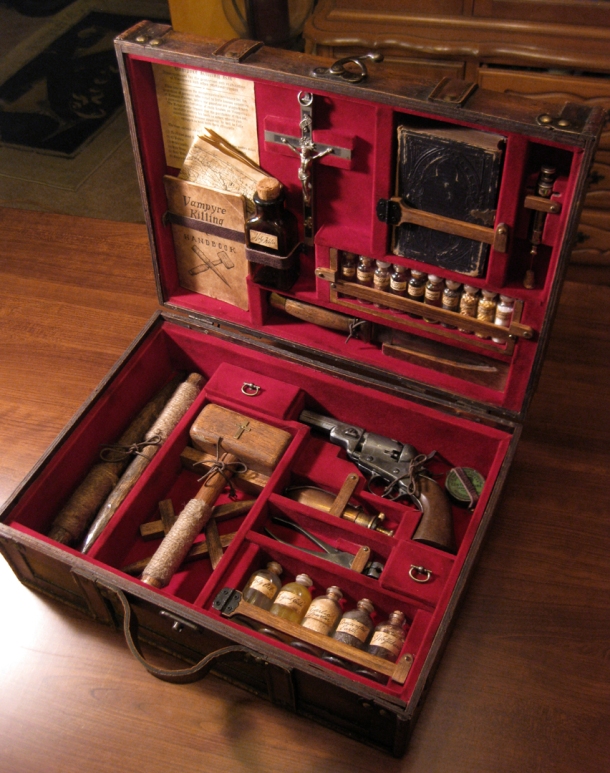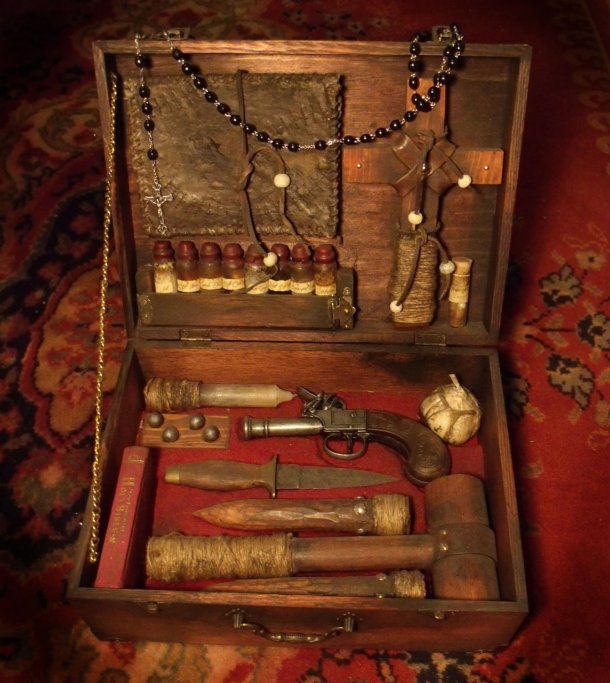
Just in time for Halloween, making rounds on the internet again are pictures and videos of 19th-century vampire-hunting kits, boxes packed tight with everything you’d need to kill vampires. Most people who have them acknowledge that their collections are replicas, but some people are sure that they’ve got the real deal. Are these kits part of a fascinating piece of history, an elaborate hoax, or commercial hokum?

There are many variations, but the kits mostly come in plain, small boxes for optimal concealment. They commonly feature pistols with silver bullets, holy water, multiple crucifixes and Bibles, hatchets, and, of course, wooden stakes. Many of the kits are attributed to one Ernst Blomberg, who (allegedly) lived in the 19th century.
Are they real? Or old? Depends on whom you ask. Many online purveyors—and the chain of Ripley’s Believe It or Not museums, which claims to have the largest collection of vampire-hunting kits—claim their kits date from around 1850, before Bram Stoker’s 1897 publication of Dracula, though not before its literary forebear, John Polidori’s The Vampyre (1819). As one of the Ripley’s exhibits argues: “The kits were purchased by wealthy Americans headed to Eastern Europe – Transylvania then, Romania now. Travelers brought back terrifying tales of vampires with them from the region—well before Dracula was brought to life by Bram Stoker.”

But there’s evidence saying otherwise. This site does great work exploring the verifiability of the kits, including the question of whether Blomberg ever existed, and provides a helpful list of items in vintage and new reproduction kits, so you can tell the difference. Its researchers conclude that while some of the kits may date before the 1970s, most are fakes less than fifty years old.
Indeed, in 2005 one Michael de Winter claimed to have invented the vampire-hunting kit—and the mysterious Ernst Blomberg—in 1972. He said that while working part-time as a dealer of antique guns in the market on Portobello Road he was inspired to create the kits as a way of selling off items no one paid attention to otherwise. Other dealers have copied him, he said. (The original post from de Winter has vanished into the internet’s memory hole, but this link has a copy of de Winter’s claims.) But a lot of people love vampires, apparently, and de Winter’s account has itself been vigorously disputed by the vampire-kit faithful.
So—true or false? Old or new? The evidence seems inclined toward false. Philadelphia’s Mercer Museum owns and exhibits one of the Blomberg kits, but a few years ago decided that it was almost certainly a mid-20th-century fake, though some parts of the kit are older. Nonetheless, it has kept its kit on view simply because of the curiosity value.
One thing is for certain, it would be pretty amazing to own one. Although the authenticity of the vampire is ambiguous, these kits have become very popular. Modern ones are still being made and sold today, and you can get a vintage version for quite a bit of money. It might be smart. Just in case.








